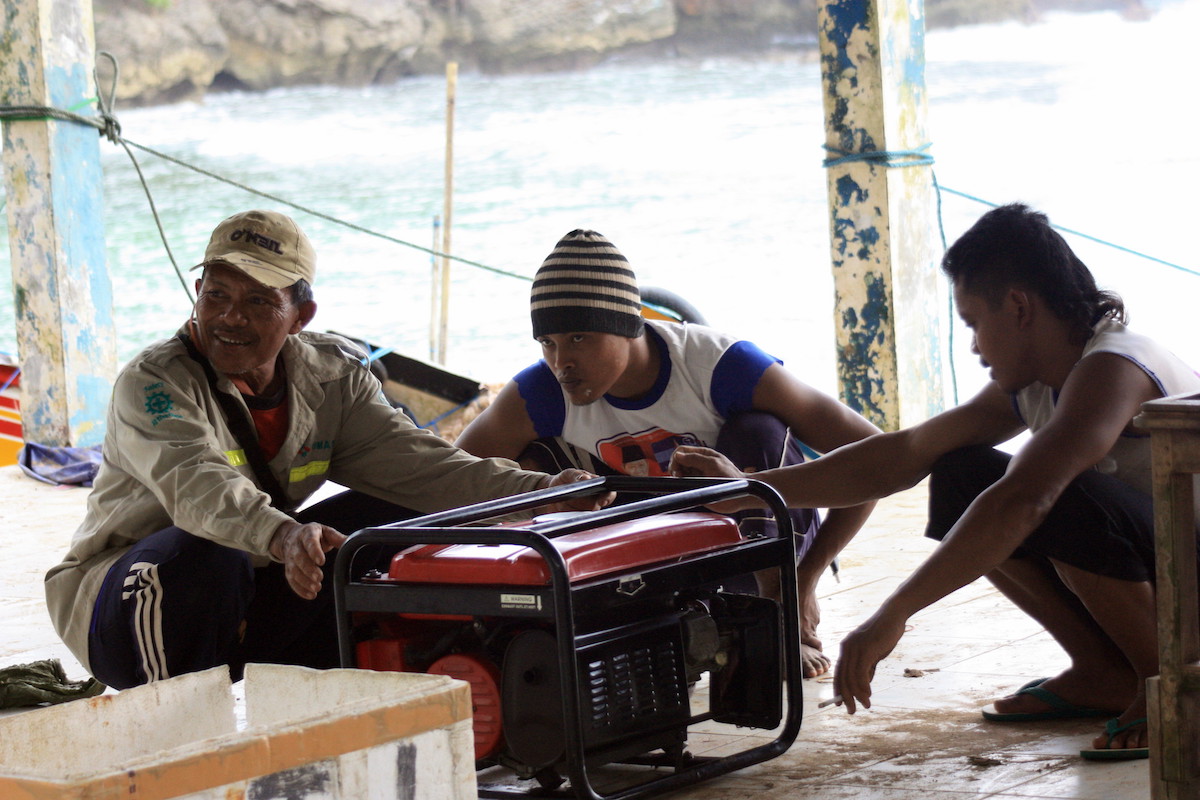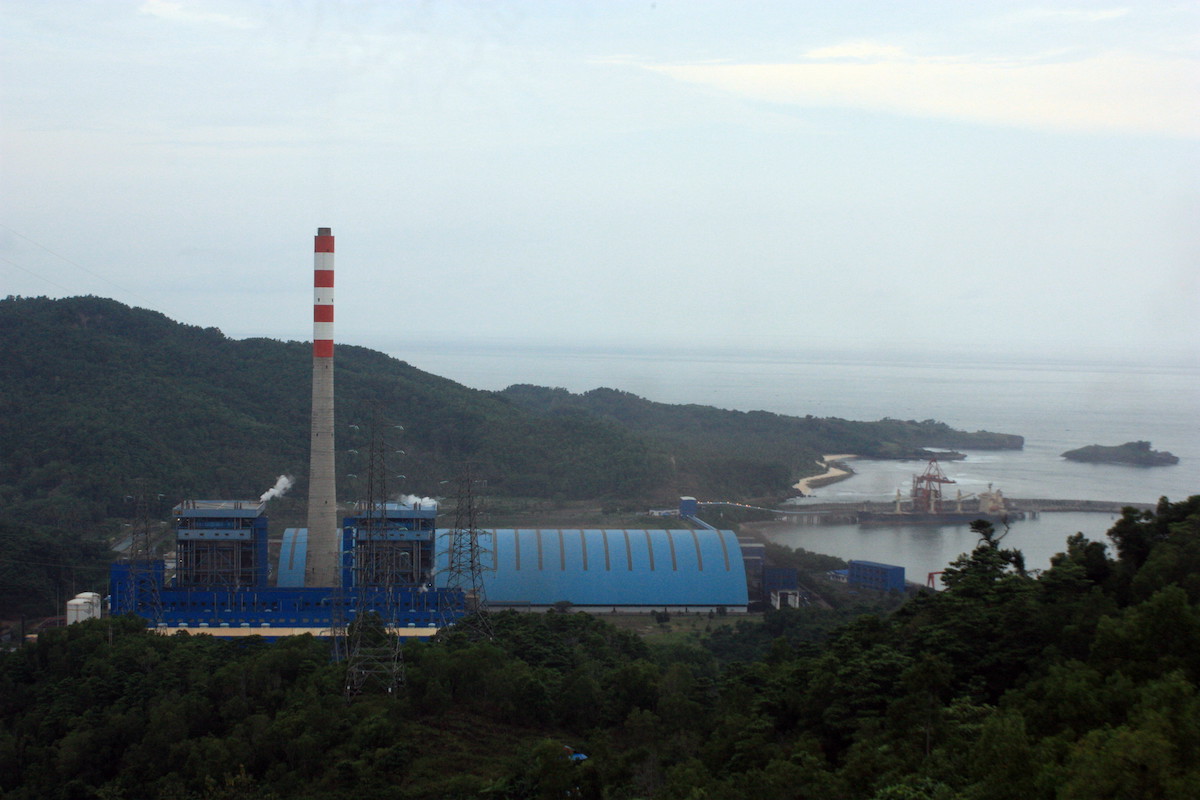- The 630-megawatt Pacitan coal-fired power plant began construction in 2007 and came online in 2013.
- Local fisherman say their catch has fallen dramatically since the project was launched, forcing them to fish much further offshore and causing conflict with the plant.
- People whose livelihoods have suffered say they have not received sufficient compensation, and that the plant offers little in the way of alternate employment for locals.
- This is the first article in a series on Pacitan originally published on Mongabay’s Indonesian-language site.
The waves of the Indian Ocean crash against the breakwater at Bawur Bay, a protective arm shielding the Pacitan coal-fired power plant. A few meters away, a barge full of coal is berthed. Its cargo is unloaded onto a conveyor belt and transported about 500 meters into a coal yard shelter reminiscent of an airplane hangar. Two 315 megawatt generators and a tall smokestack stand nearby.
Misnadi’s house lies about two kilometers to the east, its front yard full of buoys and nets marking him as a fisherman. Misnadi, who like many Indonesians goes by one name, is a resident of Sumberejo village in East Java’s Pacitan district.
Misnadi used to fish just offshore in the Kondang Bay. Now, he told Mongabay-Indonesia, he has stopped looking for fish and shrimp there. Since construction began on the coal plant in 2007, he and other fishermen have avoided the area.

The power plant has changed the map for the fishermen, compromising their livelihood. As fishermen grew frustrated, their relationship with the power plant became increasingly tense, Misnadi said.
In hopes of avoiding conflict, the subdistrict leadership forum contacted Misnadi, who was then the head of the Sumberejo Fishermen’s Group. “I told them we are trying to earn a living, so even if we’re being shot at, we’ll do it anyway,” he said. “In the end we came up with a shift system. When the project people are working, we don’t go fishing. When they stop working, we go fishing.”
Despite that agreement, fishermen — especially those from the villages of Karangturi, Karangrejo, and Ngobyok — are reluctant to fish in the area. “The power plant has limited our activities,” Misnadi said. “We can’t cast our nets, there are ships going everywhere, it’s not pleasant. … In the end, the fishermen avoid the area.”
For Misnadi, the Kondang Bay is his main source of livelihood. In the past, he recalled, his shrimp yield in the high season could reach up to 12 million rupiah ($902) per day. His daily yield is now about 200,000 rupiah ($15).
To earn as much as he did before the plant was built, Misnadi now has to sail further into the bay, often traveling up to 25 miles (about 40 kilometers) offshore in search of fish and shrimp. But finding a new place to fish is not a simple matter of steering his boat to more fruitful waters. Misnadi also has to navigate the unwritten rules of the local fishing communities, which dictate that fishermen from one area are not at liberty to fish in waters traditionally harvested by other communities.

Misnadi said he and a few other fishermen, together with the subdistrict leadership and the Sumberejo village head, brought their concerns about fishing areas to the power plant’s office.
“I explained to them how our livelihood has been impacted by the power plant. They gave us 26 million rupiah ($ 1,954) as a one-time compensation,” Misnadi said. Of that money, 6 million rupiah was used to help young fishermen, 15 million rupiah to buy new fishing equipment, and the rest was for other costs.
“We fishermen demanded 6 million rupian ($451) per year in compensation,” Misnadi said, explaining that they planned to divide the compensation among three groups of forty fishermen each. “The power plant responded that they cannot promise this, and that they cannot give that much. After we handed over our group to younger fishermen, they have not asked this [of the power plant] again.”
The funds Misnadi hoped for have not materialized since the new group of organizers took over.

Sucipto, who served in Pacitan’s local parliament from 1999-2004 and 2004-2009, is now the coordinator of the cleaning service at the Pacitan Steam Power Plant. In an attempt to bring together the local community, power plant workers and the plant’s ownership he established a forum called Masker (Masyarakat dan Pekerja Sudimoro, the Sudimoro Community and Workers Forum).
In October, he agreed to meet with Mongabay-Indonesia at Cagak Telu, a rest area at the top of a limestone hill overlooking the power plant.
“I only joined the power plant about three years ago,” he said. “At that time I was asked to take care of the folks there. So, I joined.” According to Sucipto, the local community is unhappy that many of the power-plant workers come from outside the area.
The Pacitan plant officially started its operations on Oct. 16, 2013. At first, there were high hopes the plant would recruit many local workers. Ultimately, few local workers ended up in managerial positions, let alone at the leadership level.
According to Sucipto, this is because the local labor force lacks the needed skills. “Their capacity in the technical fields, machinery, electricity, is not yet developed enough,” he said. “There are also very few local people at the management level. More of them entered at the level of manual labor — the cleaning crew and so on. We have indeed insisted that there, at least, they should hire people from Sudimoro.” However, the fact that the plant provides some local employment has had a positive effect on the community, Sucipto argued.

A Sumberejo native named Jemingan told Mongabay-Indonesia his son, a freelance welder at the plant, is one such example. He is paid 90,000 rupiah (about $ 6.80) per working day, and only works when the plant needs his services. “It’s better than idling at home. So he has something to do,” Jemingan said.
In addition to recruiting local workers, the power plant has also fueled a boom in food stalls around the plant. The bustling market at Cagak Telu is one such place. The food stalls there cater to passersby and also the power plant workers. Some also serve Chinese food, an artifact of the plant’s labor force.
A consortium between a Chinese company, Dongfang Electric Company, and a local company, PT Dalle Energy, carried out the engineering, procurement and construction of the power plant. Some of the machinery used in the factory was Chinese, and a group of Chinese workers were also brought to Sudimoro to install it. Their barracks were built at the east bank of Bawur River. Now, those barracks are gone.
China itself has recently taken aggressive moves to reduce its own dependence on coal power, but Indonesia appears committed to expansion. In June 2015, for example, Dongfang signed a contract with PT DSSP Power, part of Indonesia’s Sinar Mas Group, to build two 100 megawatt coal-fired power plants in Central Kalimantan Province in Indonesian Borneo.
Continue to Part II of the series.
This story was reported by Mongabay’s Indonesia team and was first published on our Indonesian site on Dec. 26, 2016.